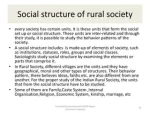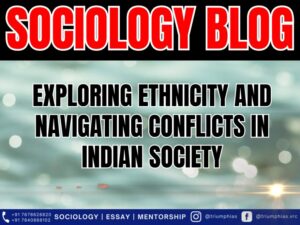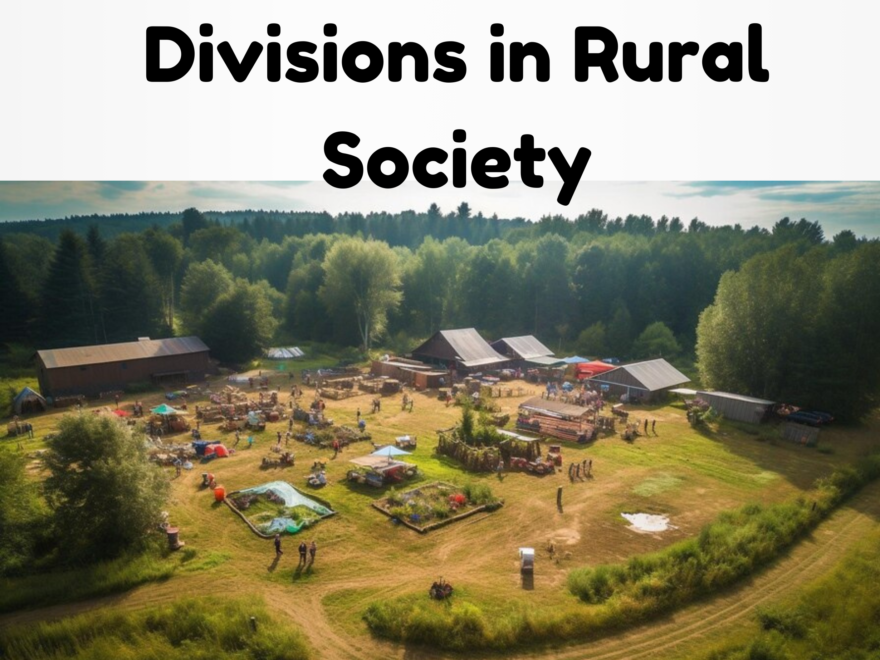Divisions in Rural Society
Relevant for Sociology Optional for Civil Service Examination.
Paper 2: Rural and Agrarian Social Structure
Divisions in Rural Society

- A faction is a small group formed on the basis of political ideology, caste power, and clashes of personalities to serve the political, social, and economic interests of a small minority. According to M. N. Srinivas the landownerships pattern, and caste and lineage systems provided the basis for factions. The division of a village into two or more mutually opposed factions was a permanent feature of rural social structure.
- A faction is a miniature form of a family. Structurally, it centres around a single individual or a group of families with a common interest, leading to different types of factions. For example :
- Peasant families owning vast landed property in a village
- Families with small holdings
- Families who have no land and earn their livelihood as laborer
- People belonging to one caste or supporting one political party or one religious ideology
- Causes behind Formation of Factions
-
- Mutual Rivalry, Conflict, and Personality Clashes: S. Dhillon observed in his book “Leadership and Groups in a South Indian Village” that rivalry and opposition to some groups is a general feature of a faction, and that a faction usually forms as a result of mutual rivalry, conflict, or personality clashes.
- Political Causes: Factions often emerge due to political struggles for power and influence. Members may seek to advance their own interests within a larger group or community, leading to the formation of factions.
- Social Causes: Social divisions, such as caste distinctions, can contribute to factionalism. Even within the same caste, factions may form based on political motivations, further dividing the community.
- Economic Causes: Economic well-being of a particular group in the village leads to faction formation. According to Satish Chandra monetisation, cash nexus and natural calamities ‘accentuated the process of social segmentation’. Chetan Singh says social stratification was greater in the more developed region due to economic prosperity.
-
- Psychological Causes:
-
- Loneliness and Fear: Individuals may join factions as a response to feelings of loneliness or fear. Being part of a group provides psychological comfort, as individuals feel supported and less alone. Fear of isolation can drive people to align themselves with a faction.
- Ego Satisfaction: Factions may arise from the ego satisfaction of those in positions of power or honour. When individuals with a sense of superiority face challenges to their ego, they may form factions to maintain dominance and seek vengeance.
-
- Research-based Causes (Oscar Lewis):
-
- Property Inheritance Disputes: Disputes related to the inheritance of property can lead to the formation of factions.
- Family Squabbles: Conflicts arising from family matters, such as disagreements over the adoption of a male child as an heir, can contribute to factionalism.
- Land and Irrigation Rights: Disputes over land and irrigation rights are identified as potential causes of factionalism.
- Sexual Offenses: Disputes and feuds may arise from sexual offenses, further contributing to the formation of factions.
-
- Inter-Factional Relationship
- Governed by Individual Leaders: The inter-factional relationship is either cordial or bitter, depending on the quality of leadership.
-
-
- Cordial: If the leader is good, considerate, benevolent, and generous, the relationship with rival factions is good.
- Bitter: If the leader is mean, intolerant, and selfish, the inter-factional relationship is better.
-
-
Features of Factions
Factions possess distinct features that define their essence and purpose. The following points outline some of these characteristic traits:
- Well-Organized Unity:
- A faction is a tightly-knit community where strength is derived from the unity and loyalty of its members.
- All members prioritize allegiance to the faction, placing its interests above their individual concerns.
- Common Interest:
- Factions revolve around a shared set of goals, objectives, aspirations, and concerns.
- Common interests such as caste solidarity, along with factors like religious, social, economic, and political considerations, drive the formation and continuity of the faction.
- Homogeneity:
- Factions are formed by cohesive groups, where individuals share similar religious beliefs, social standing, economic aspirations, or political ideologies.
- The faction persists as long as its members maintain a common interest, emphasizing the inability of heterogeneous elements to form a faction.
- Self-Sufficiency:
- Factions are self-contained entities, and their effectiveness depends on an optimal size—not too small or too large.
- The faction should be capable of meeting its members’ needs, independently organizing social or religious events, and preserving its distinct identity.
- Economic Viability:
- Financial independence is a key characteristic of factions, as they receive no external financial support.
- Members must contribute generously or secure funds internally to ensure the faction’s financial stability, preventing the jeopardy of members’ financial well-being and potential disintegration.
Reference: Static Portion
Related Blogs…
 |
 |
Frequently Asked Questions:
1. Question: Define the term “ethnic movement” and provide an example from India.
Answer: An ethnic movement refers to a collective effort by a group sharing common cultural, linguistic, or religious traits, seeking to assert their identity and rights; an example from India is the Khalistan Movement in Punjab.
2. Question: Identify the main objectives behind the Gorkhaland ethnic movement.
Answer: The Gorkhaland ethnic movement primarily seeks to establish a separate state for India’s Nepali-speaking population in the Darjeeling region, advocating for linguistic and cultural recognition and political autonomy.
3. Question: What was the Operation Blue Star, and which ethnic movement was it related to?
Answer: Operation Blue Star was a military action in 1984, aiming to remove Sikh militants hiding in the Golden Temple in Amritsar; it is related to the Khalistan movement, which sought a separate Sikh country.
4. Question: Mention a critical factor that triggered the emergence of ethnic movements in India, as discussed by Dipankar Gupta.
Answer: Dipankar Gupta emphasized that ethnicity is fundamentally a political process, wherein caste and religion, the key components of identity formation, are politicized by leaders for vested interests.
5. Question: What were the primary reasons for the Assam Ethnicity conflicts involving Bodo tribals and Bengali Muslim settlers?
Answer: The Assam Ethnicity conflicts primarily stemmed from issues related to immigration, land rights, and resource allocation, leading to clashes, riots, and evolving relationships among indigenous communities to address challenges.
6. Question: Briefly describe the role of the Dravidian Movement in terms of caste and societal structure.
Answer: The Dravidian Movement, led notably by E.V. Ramasamy, aimed to establish an egalitarian society, focusing on anti-Brahmanism and advocating for equal rights for backward castes, while also introducing reforms like self-respect marriages.
7. Question: Name the prominent ethnic movements in North-East India and specify one common objective.
Answer: Prominent ethnic movements in North-East India include the Nagas’ and Mizos’ struggles; a common objective was to gain autonomy and recognition for their distinct tribal identities and cultural uniqueness.
8. Question: What is the key argument of Gail Omveldt regarding traditional Indian society and multiculturalism?
Answer: Gail Omveldt opposed romanticizing traditional Indian society, arguing that hierarchy has always dominated it and dismissing the notion that multiculturalism is an intrinsic feature of Indian society as a myth.
9. Question: Briefly explain the social hierarchy factor as a contributing element to ethnic movements as suggested by Olzak.
Answer: Olzak suggests that the construction of hierarchies among ethnic communities, which often leads to the suppression of one group by another, is a key factor that can instigate social and ethnic movements.
10. Question: Identify one consequence of the unequal economic development factor within the context of ethnic movements in India.
Answer: One consequence of unequal economic development is the marginalization and underdevelopment of certain groups, leading to feelings of alienation and sometimes initiating ethnic movements as these groups strive for equality and recognition.
GS Related Practices Questions…
To master these intricacies and fare well in the Sociology Optional Syllabus, aspiring sociologists might benefit from guidance by the Best Sociology Optional Teacher and participation in the Best Sociology Optional Coaching. These avenues provide comprehensive assistance, ensuring a solid understanding of sociology’s diverse methodologies and techniques.
META TAGS:
Ethnic Movements, ethnic movements in india, ethnic movement in sociology, Punjab Movement, North-East Ethnic Movements, Gorkhaland Movement, Dravidian Movement, Assam Ethnicity, Ethnic Conflicts, Sociopolitical Impact, India, Ethnic Consciousness, Ethnic Rights, Political Crisis, Economic Development, Cultural Disparities, Khalistan Movement, Nagaland, Mizoram, Multiculturalism, Political Economy, Identity Formation, Social Hierarchies, Bodo Tribals, Bengali Muslim Settlers, Anti-Sikh Riots, Operation Blue Star, Unequal Development, Ethnic Violence, Political Mobilization

Why Vikash Ranjan’s Classes for Sociology?
Proper guidance and assistance are required to learn the skill of interlinking current happenings with the conventional topics. VIKASH RANJAN SIR at TRIUMPH IAS guides students according to the Recent Trends of UPSC, making him the Best Sociology Teacher for Sociology Optional UPSC.
At Triumph IAS, the Best Sociology Optional Coaching platform, we not only provide the best study material and applied classes for Sociology for IAS but also conduct regular assignments and class tests to assess candidates’ writing skills and understanding of the subject.
Choose The Best Sociology Optional Teacher for IAS Preparation?
At the beginning of the journey for Civil Services Examination preparation, many students face a pivotal decision – selecting their optional subject. Questions such as “which optional subject is the best?” and “which optional subject is the most scoring?” frequently come to mind. Choosing the right optional subject, like choosing the best sociology optional teacher, is a subjective yet vital step that requires a thoughtful decision based on facts. A misstep in this crucial decision can indeed prove disastrous.
Ever since the exam pattern was revamped in 2013, the UPSC has eliminated the need for a second optional subject. Now, candidates have to choose only one optional subject for the UPSC Mains, which has two papers of 250 marks each. One of the compelling choices for many has been the sociology optional. However, it’s strongly advised to decide on your optional subject for mains well ahead of time to get sufficient time to complete the syllabus. After all, most students score similarly in General Studies Papers; it’s the score in the optional subject & essay that contributes significantly to the final selection.
“A sound strategy does not rely solely on the popular
Opinion of toppers or famous YouTubers cum teachers.”
It requires understanding one’s ability, interest, and the relevance of the subject, not just for the exam but also for life in general. Hence, when selecting the best sociology teacher, one must consider the usefulness of sociology optional coaching in General Studies, Essay, and Personality Test.
The choice of the optional subject should be based on objective criteria, such as the nature, scope, and size of the syllabus, uniformity and stability in the question pattern, relevance of the syllabic content in daily life in society, and the availability of study material and guidance. For example, choosing the best sociology optional coaching can ensure access to top-quality study materials and experienced teachers. Always remember, the approach of the UPSC optional subject differs from your academic studies of subjects. Therefore, before settling for sociology optional, you need to analyze the syllabus, previous years’ pattern, subject requirements (be it ideal, visionary, numerical, conceptual theoretical), and your comfort level with the subject.
This decision marks a critical point in your UPSC – CSE journey, potentially determining your success in a career in IAS/Civil Services. Therefore, it’s crucial to choose wisely, whether it’s the optional subject or the best sociology optional teacher. Always base your decision on accurate facts, and never let your emotional biases guide your choices. After all, the search for the best sociology optional coaching is about finding the perfect fit for your unique academic needs and aspirations.
To master these intricacies and fare well in the Sociology Optional Syllabus, aspiring sociologists might benefit from guidance by the Best Sociology Optional Teacher and participation in the Best Sociology Optional Coaching. These avenues provide comprehensive assistance, ensuring a solid understanding of sociology’s diverse methodologies and techniques. Sociology, Social theory, Best Sociology Optional Teacher, Best Sociology Optional Coaching, Sociology Optional Syllabus.
Best Sociology Optional Teacher, Sociology Syllabus, Sociology Optional, Sociology Optional Coaching, Best Sociology Optional Coaching, Best Sociology Teacher, Sociology Course, Sociology Teacher, Sociology Foundation, Sociology Foundation Course, Sociology Optional UPSC, Sociology for IAS,
Follow us :



Find More Blogs…
| Compare and contrast Karl Marx’s and Max weber’s | Karl Marx- Historical Materialism |
| Talcott Parsons : Social system | Scope of the subject and comparison with other social sciences |
KEYWORD: – Divisions in Rural Society,Divisions in Rural Society,Divisions in Rural Society,Divisions in Rural Society,Divisions in Rural Society,Divisions in Rural Society,Divisions in Rural Society,Divisions in Rural Society,Divisions in Rural Society,Divisions in Rural Society,Divisions in Rural Society,Divisions in Rural Society, Divisions in Rural Society,Divisions in Rural Society, Divisions in Rural Society


